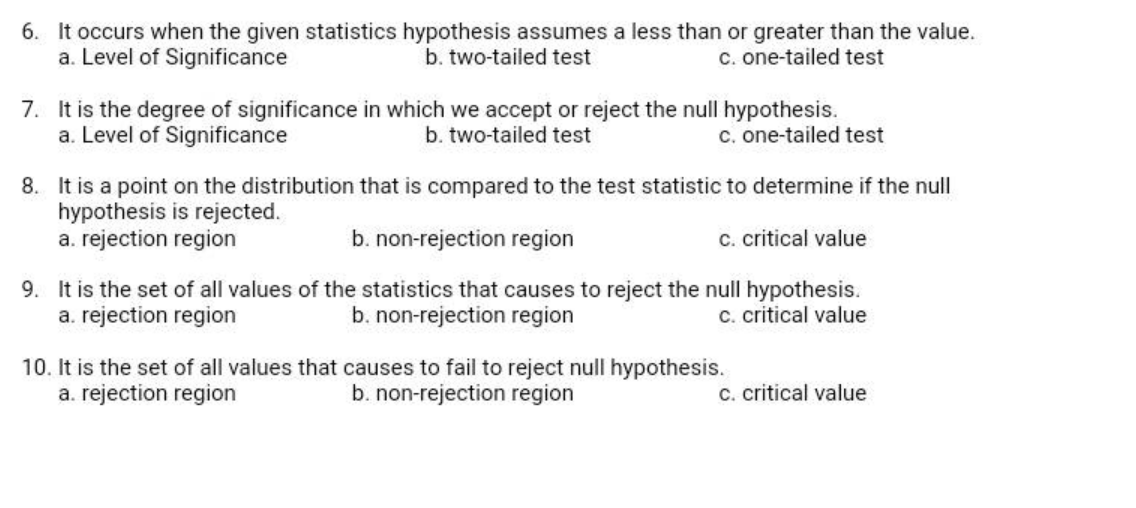5. It occurs when the given statistics hypothesis assumes a less than or greater than the value. a. Level of Significance b. two-tailed test C. one-tailed test 7. It is the degree of significance in which we accept or reject the null hypothesis. a. Level of Significance b. two-tailed test c. one-tailed test 3. It is a point on the distribution that is compared to the test statistic to determine if the null hypothesis is rejected. a. rejection region b. non-rejection region c. critical value 9. It is the set of all values of the statistics that causes to reject the null hypothesis. b. non-rejection region a. rejection region c. critical value 10. It is the set of all values that causes to fail to reject null hypothesis. a. rejection region b. non-rejection region c. critical value
5. It occurs when the given statistics hypothesis assumes a less than or greater than the value. a. Level of Significance b. two-tailed test C. one-tailed test 7. It is the degree of significance in which we accept or reject the null hypothesis. a. Level of Significance b. two-tailed test c. one-tailed test 3. It is a point on the distribution that is compared to the test statistic to determine if the null hypothesis is rejected. a. rejection region b. non-rejection region c. critical value 9. It is the set of all values of the statistics that causes to reject the null hypothesis. b. non-rejection region a. rejection region c. critical value 10. It is the set of all values that causes to fail to reject null hypothesis. a. rejection region b. non-rejection region c. critical value
Glencoe Algebra 1, Student Edition, 9780079039897, 0079039898, 2018
18th Edition
ISBN:9780079039897
Author:Carter
Publisher:Carter
Chapter10: Statistics
Section10.4: Distributions Of Data
Problem 19PFA
Related questions
Question

Transcribed Image Text:6. It occurs when the given statistics hypothesis assumes a less than or greater than the value.
a. Level of Significance
b. two-tailed test
c. one-tailed test
7. It is the degree of significance in which we accept or reject the null hypothesis.
a. Level of Significance
b. two-tailed test
c. one-tailed test
8. It is a point on the distribution that is compared to the test statistic to determine if the null
hypothesis is rejected.
a. rejection region
b. non-rejection region
C. critical value
9. It is the set of all values of the statistics that causes to reject the null hypothesis.
b. non-rejection region
c. critical value
a. rejection region
10. It is the set of all values that causes to fail to reject null hypothesis.
a. rejection region
b. non-rejection region
C. critical value
Expert Solution
This question has been solved!
Explore an expertly crafted, step-by-step solution for a thorough understanding of key concepts.
Step by step
Solved in 6 steps

Recommended textbooks for you

Glencoe Algebra 1, Student Edition, 9780079039897…
Algebra
ISBN:
9780079039897
Author:
Carter
Publisher:
McGraw Hill

Glencoe Algebra 1, Student Edition, 9780079039897…
Algebra
ISBN:
9780079039897
Author:
Carter
Publisher:
McGraw Hill